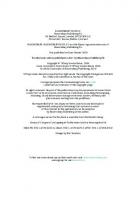Foraging Theory 0-691-08442-4
"This book should prove to be an extremely important and most welcome contribution to the field. The text collects
212 13 12MB
English Pages 259 Year 1986
Table of contents :
- Preface
- Acknowledgments
1. "Foraging Economics: The Logic of Formal Modeling"
1.1. Introduction
1.2 The Elements of Foraging Models
1.3 Decision Assumptions
1.4 Currency Assumptions
1.5 Constraint Assumptions
1.6 Lost Opportunity
1.7 Summary
2 Average-Rate Maximizing: The Prey and Patch Models
2.1 Some General Comments
2.2 The Prey Model: Search or Eat?
2.3 The Patch Model: How Long to Stay?
2.4 Combining the Prey and Patch Models
2.5 Limitations
2.6 More Decisions for the Average-Rate Maximizer
2.7 Summary
3. "Average-Rate Maximizing Again: Changed Constraints"
3.1 Introduction
3.2 Sequential versus Simultaneous Encounter
3.3 Exclusivity of Search and Handling
3.4 Prey Choice with Sequential Dependence
3.5 Travel Restrictions and Central-Place Foraging
3.6 Nutrients and Toxins as Constraints
3.7 Recognition Constraints
3.8 Conclusion
3.9 Summary
4. "Incomplete Information"
4.1 Introduction
4.2 The Value of Recognition
4.3 Tracking a Changing Environment
4.4 Patch Sampling
4.5 How Are These Problems Related?
4.6 Summary
5. "The Economics of Choice: Trade-offs and Herbivory"
5.1 Introduction
5.2 Economics of Consumer Choice
5.3 Economic Choice and Animal Psychology
5.4 Studies of Trade-offs: Birds are Tame in Winter
5.5 Nutrients and Diet Choice by Herbivores
5.6 Summary
6. "Risk-Sensitive Foraging"
6.1 Introduction
6.2 Risk and Utility
6.3 Risk-Sensitive Feeding Behavior
6.4 Shortfall Models of Risk Taking: The Z-Score Model
6.5 A Descriptive Model of Risk Taking
6.6 Impulsiveness, Hunger, and Time Discounting
6.7 Summary
7. "Dynamic Optimization: The Logic of Multi-Stage Decision Making"
7.1 Introduction
7.2 Solving for Decision Functions: The PMP
7.3 Trade-offs and Dynamic Optimization
7.4 Conclusions
7.5 Summary
8 "More on Constraints: Rules of Thumb and Satisficing"
8.1 Introduction
8.2 Behavioral Constraints: Rules of Thumb
8.3 The Performance of Rules of Thumb
8.4 Rules of Thumb: Experimental Evidence
8.5 Rules for Switching on Concurrent Schedules
8.6 Satisficing and Constraints
8.7 Concluding Remarks: Constraint versus Design
8.8 Summary
9. "Testing Foraging Models"
9.1 Foraging Models and Data
9.2 Testing Foraging Models
9.3 How Well Does Foraging Theory Do?
9.4 Pitfalls in Testing Foraging Models
9.5 Sufficient Tests?
9.6 Summary
1O. "Optimization Models in Behavioral Ecology: The Spandrel Meets Its Arch-Rival"
10.1 Introduction
10.2 What Is Wrong with Optimization Models?
10.3 Optimization and Newton's Second Coming
10.4 Alternatives to Optimization?
10.5 Summary
- References and Index of Citations
- Subject Index
- Preface
- Acknowledgments
1. "Foraging Economics: The Logic of Formal Modeling"
1.1. Introduction
1.2 The Elements of Foraging Models
1.3 Decision Assumptions
1.4 Currency Assumptions
1.5 Constraint Assumptions
1.6 Lost Opportunity
1.7 Summary
2 Average-Rate Maximizing: The Prey and Patch Models
2.1 Some General Comments
2.2 The Prey Model: Search or Eat?
2.3 The Patch Model: How Long to Stay?
2.4 Combining the Prey and Patch Models
2.5 Limitations
2.6 More Decisions for the Average-Rate Maximizer
2.7 Summary
3. "Average-Rate Maximizing Again: Changed Constraints"
3.1 Introduction
3.2 Sequential versus Simultaneous Encounter
3.3 Exclusivity of Search and Handling
3.4 Prey Choice with Sequential Dependence
3.5 Travel Restrictions and Central-Place Foraging
3.6 Nutrients and Toxins as Constraints
3.7 Recognition Constraints
3.8 Conclusion
3.9 Summary
4. "Incomplete Information"
4.1 Introduction
4.2 The Value of Recognition
4.3 Tracking a Changing Environment
4.4 Patch Sampling
4.5 How Are These Problems Related?
4.6 Summary
5. "The Economics of Choice: Trade-offs and Herbivory"
5.1 Introduction
5.2 Economics of Consumer Choice
5.3 Economic Choice and Animal Psychology
5.4 Studies of Trade-offs: Birds are Tame in Winter
5.5 Nutrients and Diet Choice by Herbivores
5.6 Summary
6. "Risk-Sensitive Foraging"
6.1 Introduction
6.2 Risk and Utility
6.3 Risk-Sensitive Feeding Behavior
6.4 Shortfall Models of Risk Taking: The Z-Score Model
6.5 A Descriptive Model of Risk Taking
6.6 Impulsiveness, Hunger, and Time Discounting
6.7 Summary
7. "Dynamic Optimization: The Logic of Multi-Stage Decision Making"
7.1 Introduction
7.2 Solving for Decision Functions: The PMP
7.3 Trade-offs and Dynamic Optimization
7.4 Conclusions
7.5 Summary
8 "More on Constraints: Rules of Thumb and Satisficing"
8.1 Introduction
8.2 Behavioral Constraints: Rules of Thumb
8.3 The Performance of Rules of Thumb
8.4 Rules of Thumb: Experimental Evidence
8.5 Rules for Switching on Concurrent Schedules
8.6 Satisficing and Constraints
8.7 Concluding Remarks: Constraint versus Design
8.8 Summary
9. "Testing Foraging Models"
9.1 Foraging Models and Data
9.2 Testing Foraging Models
9.3 How Well Does Foraging Theory Do?
9.4 Pitfalls in Testing Foraging Models
9.5 Sufficient Tests?
9.6 Summary
1O. "Optimization Models in Behavioral Ecology: The Spandrel Meets Its Arch-Rival"
10.1 Introduction
10.2 What Is Wrong with Optimization Models?
10.3 Optimization and Newton's Second Coming
10.4 Alternatives to Optimization?
10.5 Summary
- References and Index of Citations
- Subject Index










